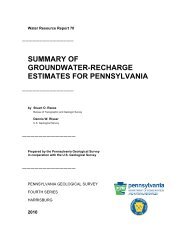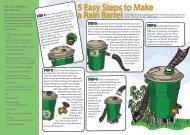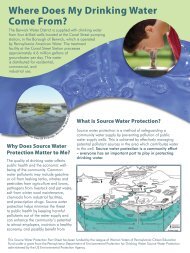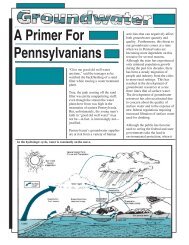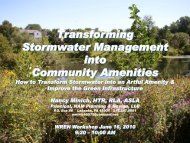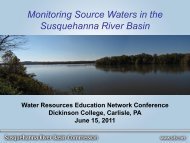NITROGEN POLLUTION: - Hubbard Brook Research Foundation
NITROGEN POLLUTION: - Hubbard Brook Research Foundation
NITROGEN POLLUTION: - Hubbard Brook Research Foundation
Create successful ePaper yourself
Turn your PDF publications into a flip-book with our unique Google optimized e-Paper software.
On warm summer days,<br />
ground-level ozone concentrations<br />
in the Northeast often<br />
14<br />
exceed the U.S. Environmental<br />
Protection Agency (EPA)<br />
12<br />
National Ambient Air Quality<br />
Standard for human health.<br />
10<br />
The current ozone standard<br />
8<br />
is 0.08 parts per million<br />
averaged over an eight-hour<br />
6<br />
period (revised from 0.12<br />
parts per million averaged<br />
4<br />
over a one-hour period).<br />
Based on the older standard,<br />
2<br />
approximately 26 million<br />
0<br />
people live in areas of the<br />
Northeast where the standard<br />
was exceeded up to 70 days<br />
from 1993-1998. It is expected<br />
that even more people will<br />
be exposed to conditions that<br />
periodically violate the current more stringent standard.<br />
Ground-level ozone also presents a significant health risk for trees and other<br />
vegetation in the Northeast. The two major categories of plant effects are injury to<br />
leaves and needles, and physiological changes. Ozone comes into contact with plants<br />
through “stomatal conductance,” or the uptake of ozone through small pores on the<br />
tree (stomates). Ozone uptake by plants is greatest during the growing season of<br />
May to October when the plants are growing most vigorously.<br />
Visual symptoms of ozone stress include<br />
damage to parts of the leaf or needle, known<br />
as “foliar stipling” or “necrotic spotting,” and<br />
premature loss of foliage. Physiological changes<br />
can also occur to the plant without visible signs<br />
of injury. The most pronounced physiological<br />
effect is the reduction in the ability of the<br />
plant to convert sunlight to energy (through<br />
photosynthesis) that is needed to fuel plant growth.<br />
The net effect of this change is a decrease in tree<br />
% Reduction in Net Primary Productivity<br />
biomass production, or growth (see Figure 10).<br />
Tip necrosis injury on white<br />
pine.<br />
l Acid rain<br />
Rainfall is acidic in much of the Northeast. The average pH (a measure of<br />
acidity) of rain and snowfall at the <strong>Hubbard</strong> <strong>Brook</strong> Experimental Forest in New<br />
Hampshire is 4.5. This level is 10-15 times more acidic than unpolluted rainwater.<br />
Recent surveys show that approximately 41 percent of lakes in the Adirondacks<br />
of New York and 15 percent in New England are chronically or periodically too<br />
acidic to support fish and other aquatic life.<br />
Nitrogen in the form of nitric acid is one of the two major constituents of acid<br />
rain (the other is sulfuric acid). As regulatory controls on sulfur dioxide emissions<br />
have decreased the amount of sulfate in rain and snow, nitrate has become an<br />
increasingly important contributor to acid rain (see Figure 11). Moreover, nitrate<br />
is the major driver in seasonal and “episodic” acidification that result in short-term<br />
increases in the acidity of surface waters. These episodes typically occur in the<br />
spring, fall and winter when trees and other vegetation are not actively growing<br />
and are therefore using less nitrogen.<br />
Syracuse, NY<br />
Lake Placid, NY<br />
NewYork, NY<br />
Schenectady, NY<br />
Danbury, CT<br />
Ware, MA<br />
Chelsea, MA<br />
Bennington, VT<br />
Manchester, NH<br />
Portsmouth, NH<br />
Cape Elizabeth, ME<br />
k<br />
ME<br />
FIGURE 10:Bangor,<br />
Reductions in tree<br />
growth in the Northeast<br />
due to ozone pollution.<br />
From Ollinger et al.<br />
1997.<br />
Purple stipling on<br />
ash leaf due to<br />
ambient ozone.<br />
Acadia National<br />
Park, ME.<br />
PAGE 12



